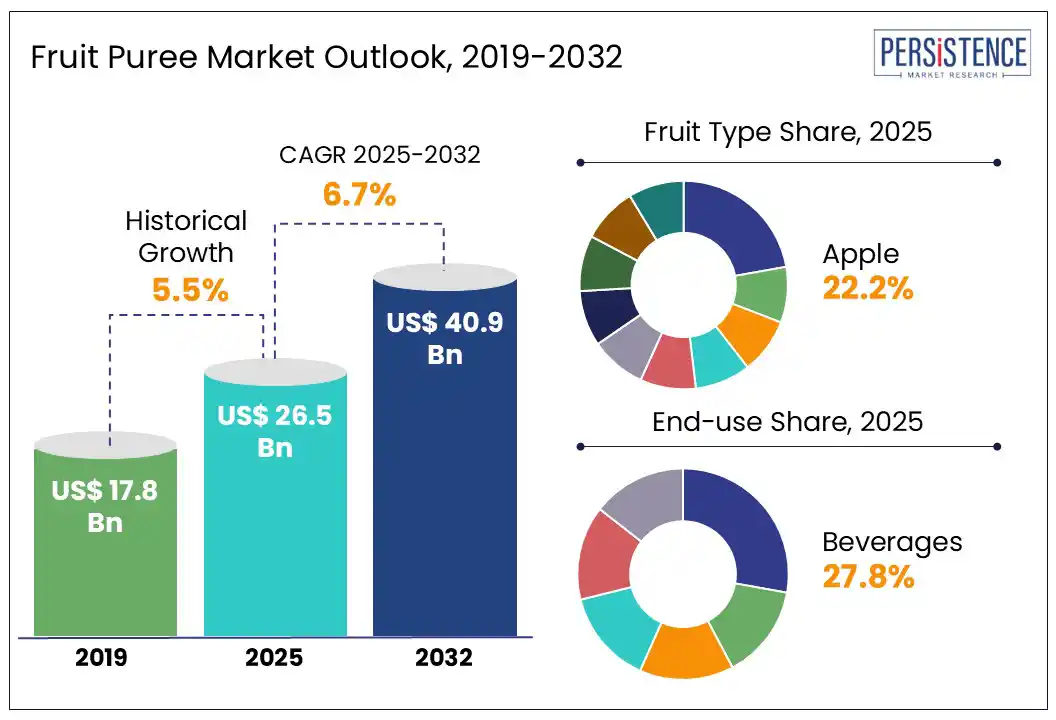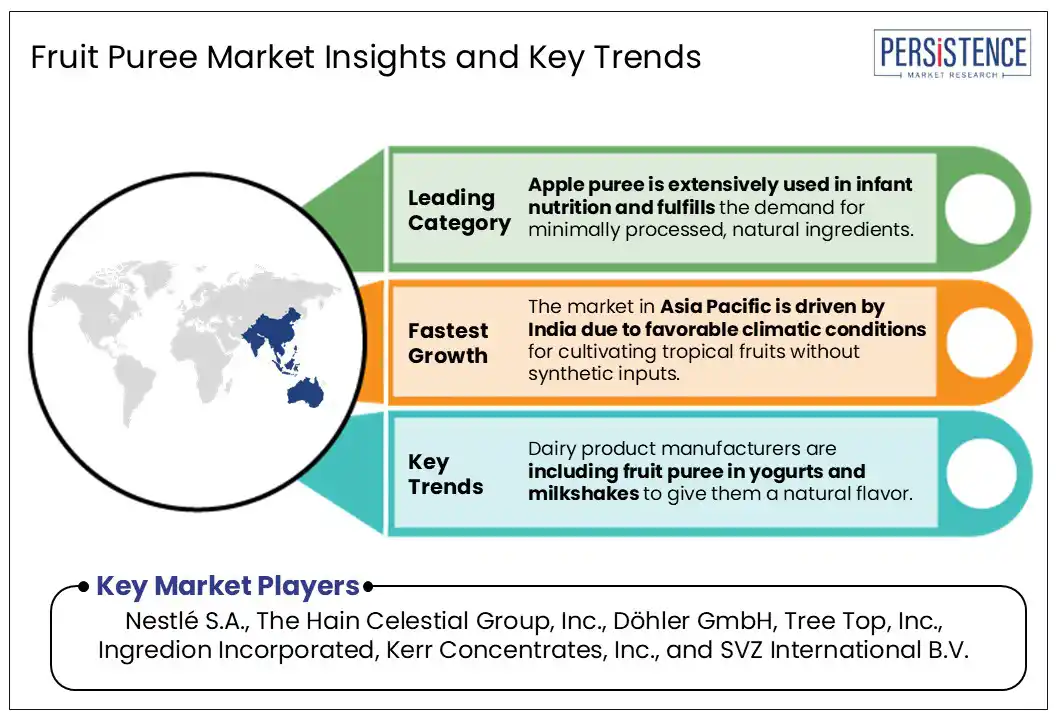ID: PMRREP32291| 191 Pages | 18 Jul 2025 | Format: PDF, Excel, PPT* | Food and Beverages

The global fruit puree market size is likely to be valued at US$ 26.5 Bn in 2025 and is estimated to reach US$ 40.9 Bn in 2032, at a CAGR of 6.7% during the forecast period 2025 - 2032.
Fruit puree is a processed blend of fruits that is smooth in texture and retains the natural flavor, color, and nutritional value of fresh produce. Their properties make it a highly versatile ingredient used extensively in beverages, baby food, bakery items, and dairy products. With consumers increasingly seeking healthier, clean-label alternatives, fruit puree has emerged as a preferred choice for both manufacturers and health-conscious buyers. As innovations in processing technologies surge and the emphasis on quality and shelf stability of food products heightens, fruit puree is likely to continue its momentum in the food and beverage industry as a key component in the evolving landscape of health-focused offerings. The fruit puree market growth is driven by rising demand for natural, functional ingredients, growing awareness of plant-based nutrition, and expanding use of fruit-based formulations in packaged and convenience foods.

Key Industry Highlights
|
Global Market Attribute |
Key Insights |
|
Fruit Puree Market Size (2025E) |
US$ 26.5 Bn |
|
Market Value Forecast (2032F) |
US$ 40.9 Bn |
|
Projected Growth (CAGR 2025 to 2032) |
6.7% |
|
Historical Market Growth (CAGR 2019 to 2024) |
5.5% |
Rising consumer preference for natural fruit-based products and clean-label ingredients is working as a major driver for the fruit puree market growth. As health-conscious buyers increasingly seek minimally processed, plant-based alternatives, fruit puree has emerged as a go-to solution for manufacturers aiming to meet this demand. The Perfect Purée of Napa Valley, for example, launched two purees, Camu and Soursop, in February 2025. The former is a tart red berry with powerful antioxidants and Vitamin C content, while the latter is a tropical fruit high in Vitamin C and fiber. The versatility and nutritional value of these purees make them ideal for a wide range of fruit-based food and beverages. This trend is significantly boosting the adoption of fruit puree across the processed fruit products industry.
One of the major restraining factors impacting the market is the increasing vulnerability of key fruit crops to climate-related disruptions, such as heatwaves and erratic monsoons, and plant diseases. The global fruit puree supply chain depends heavily on a narrow set of climate-sensitive fruits such as mangoes, bananas, guavas, and berries, which are predominantly cultivated in tropical and subtropical regions. For instance, India experienced a significant drop in Alphonso mango production in 2023 due to a combination of heatwaves and delayed monsoons, leading to an approximately 60% yield loss in major growing areas, according to a report by the Hindu Business Line.
Such volatility disrupts puree processing schedules and drives up input costs, limiting the scalability of fruit puree production. In addition to climate pressures, the spread of crop diseases is further constraining the growth of the fruit puree industry. The outbreak of Fusarium wilt (TR4) in Latin American banana plantations raised serious concerns about the long-term availability of banana puree for food and beverage applications.
The growing demand for clean-label and natural ingredients is generating significant opportunities for dairy and dessert brands to innovate with fruit purees. Brands are already incorporating fruit purees into flavored yogurts, milkshakes, and plant-based desserts. An exciting innovation in this context is mixed fruit blends that are being explored for their unique flavor characteristics. For instance, in February 2025, Siggi’s Yogurt introduced a novel flavor called Spiced Fig & Pear, which is 1.5% milkfat yogurt that balances the warm hints of cinnamon and cardamom with the sweetness of fig and pear. As consumers increasingly seek healthier, minimally processed options, fruit purees offer a versatile, nutrient-rich solution that aligns with these preferences.
Based on fruit type, the market has been divided into apple, banana, strawberry, mango, guava, passion fruit, cranberry, blueberry, cherry, and blackcurrant. The apple segment is projected to capture a 22.2% market share by 2025, driven by its widespread use in infant nutrition and the rising demand for minimally processed, natural ingredients. Leading brands such as Earth's Best and Gerber are expanding their organic apple puree offerings to meet consumer preferences for transparency and health.
Meanwhile, banana puree is expected to witness steady growth through 2032, particularly in plant-based and vegan product lines. Its creamy texture and natural sweetness make it an ideal sugar substitute in baby food, beverages, and dairy alternatives, aligning with the market’s shift toward healthier, plant-forward innovations.
By end-use, the fruit puree market segments include bakery, infant food, dairy & desserts, dressing & sauces, beverages, and others. Among these, the beverages segment is expected to dominate the market with a projected 27.8% share by 2025, fueled by rising consumer demand for nutrient-rich, organic drinks. Beverage brands such as Bolthouse Farms, Tropicana, and Naked Juice are incorporating berry, banana, and mango purees into their product lines to meet the rising consumer inclination toward clean-label and fresh ingredients. Fruit-based smoothies and health beverages are gaining popularity among busy, health-conscious consumers seeking on-the-go nutrition.
The dressings & sauces segment is projected to grow steadily through 2032, fueled by the trend toward low-sugar and functional fruit formulations. Naturally sweet purees are being adopted by brands such as Bolthouse Farms that are actively substituting refined sugar with fruit puree in yogurt-based dressings to produce a balanced flavor profile.

Asia Pacific is projected to hold 34.7% of the fruit puree market share during the forecast period. India is expected to witness rapid growth due to favorable climatic conditions for cultivating tropical fruits without synthetic inputs. As of March 2020, 2.7 million hectares were under organic farming, with Madhya Pradesh, Rajasthan, and Maharashtra contributing nearly 50% of organic fruit cultivation. This surge in organic fruit puree availability is enabling food and beverage brands to meet the growing demand for healthy, plant-based, and functional formulations. In China, market growth is fueled by the increasing use of fruit purees in desserts and convenience foods, catering to the busy working-class population.
In North America, especially the U.S., the demand for mixed fruit purees is rising due to their unique flavor profiles and nutritional benefits. These blends offer a rich source of vitamins and minerals, aligning with clean-label and health-focused trends. Companies such as Fierce Fruit are leading the way with 100% real, aseptic, all-natural purees free from added sugars and artificial ingredients. More small-scale producers are also expected to enter this market, expanding opportunities in the U.S. fruit puree market.
In Europe, France is witnessing a steady growth in the fruit puree market, driven by the popularity of traditional clean-label desserts such as compotes. In 2021, over 437,000 tons of apple compotes were sold in France, with approximately 86?percent of the apples used being sourced domestically. This preference for locally produced natural ingredients is boosting the demand for fruit puree. Meanwhile, Germany’s market is expanding through 2032, fueled by the use of fruit purees in food sector applications, especially in smoothies and cocktails. The trend reflects the growing consumer interest in plant-based protein, functional, and flavorful menu options.
The global fruit puree market landscape is becoming increasingly competitive, with both large and small companies launching innovative, clean-label products to meet rising demand for real fruit-based ingredients. Key players are focusing on organic, additive-free formulations and targeting food and beverage manufacturers. Strategic moves such as mergers, acquisitions, and partnerships with local brands are also on the rise to co-develop functional and plant-based offerings that align with evolving consumer preferences.
The market is set to reach US$ 26.5 Bn in 2025.
The industry will likely be valued at US$ 40.9 Bn in 2032.
The industry is set to surge at a CAGR of 6.7% through 2032.
SVZ Industrial Fruit & Vegetable Ingredients, Kiril Mischeff, and Kanegrade are a few key companies.
Apple puree is projected to be the leading product type in 2025.
|
Report Attribute |
Details |
|
Historical Data/Actuals |
2019 - 2024 |
|
Forecast Period |
2025 - 2032 |
|
Market Analysis Units |
Value: US$ Bn |
|
Geographical Coverage |
|
|
Segmental Coverage |
|
|
Competitive Analysis |
|
|
Report Highlights |
|
|
Customization and Pricing |
Available upon request |
By Fruit Type
By Nature
By End-use
By Region
Delivery Timelines
For more information on this report and its delivery timelines please get in touch with our sales team.
About Author